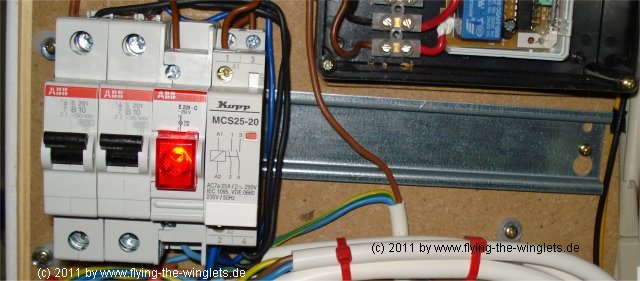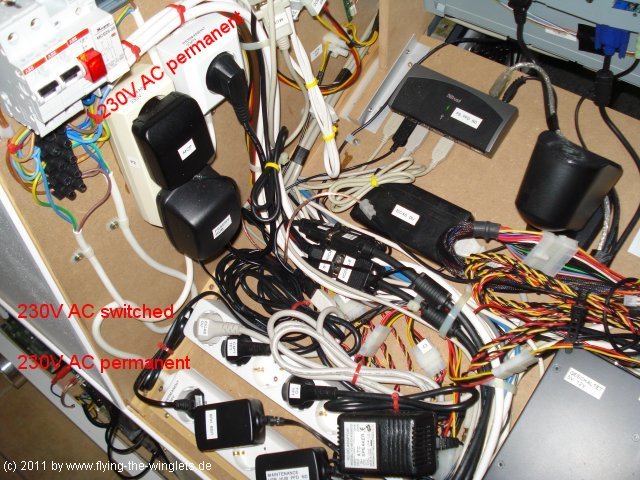Power Supply
Introduction
The power consumption of a flight simulator
installation can become quite high, depending on the
number of computers, monitors, projectors and other
consumers.
Supplying all of them via a single power cable and a
daisy chain of
multiple
socket
outlets might not a
very good idea. The wiring might get hot and
problems can occur including fire. Hence
the projection of the electricity supply should be a
mandatory part of a flight simulator project. Another aspect for safety is a correct protective earth
wiring.
Electrical Setup
The power supply of the complete installation is
subdivided into several 230V AV circuits. From the house fuse
panel 3 dedicated power lines, each fused with a 16A
B-Type circuit
breaker, are available exclusively for the flight simulator room:
Line 1: Flight deck
Line 2: Computer rack and projectors
Line 3: Power-line network adapter
Plugging the power-line network adapter to a dedicated power line increased the data throughput by approx. 25%.
Flight Deck Power Supply
Inside the electronic compartment of the flight deck the 230V power line is subdivided into
2 circuits. Each of the circuits has its own 10A
automatic circuit breaker. The circuit breakers are
followed by an electrical contactor. This contactor acts as
the main power switch of the flight deck. The
contactor is controlled by a RF hand remote control.
So I can switch on / off the flight deck very comfortable
just by pressing a small pushbutton on the remote
control. Other channels of the remote control or
used for different purposes, e.g. to control the
ambient light.

10 A circuit breakers, control light,
contactor and RF receiver for remote control (upper
right corner of the image)

Multi-outlet power strips with 230V. One of
them provides
permanent voltage and the other one gets activated with
the battery switch 'ON'.
The internal power supplies are providing the
following voltage ranges:
230V AC
+12 V DC
+5 V DC
+5V / +12V DC
The +5V and the +12V DC power supplies are
available twice each. I use 2 standard ATX PC power supplies
for that purpose. With activating the flight deck one of the ATX power supplies
gets immediately active and supplies the interfaces
boards and some other circuits. The second ATX power
supply gets active with the battery switch of the
overhead in its 'ON' position and supplies e.g. the
backlit of the MIP and AFT electronic panels, and
cooling fans..
230V AC
The same applies to the 230V AC circuits: One becomes
active immediately, the second one gets activated with the battery
switch in the 'ON'
position. Physically the 230V
are switched by a 25 ampere semiconductor relay.
Links:
Conrad:
http://www.conrad.de/ Search for 'Elektronisches
Lastrelais CW-Serie Crydom CWD2425',
Best.-Nr.:
505184 - 62